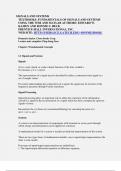SIGNALS AND SYSTEMS TEXTBOOKS: FUNDAMENTALS OF SIGNALS AND SYSTEMS USING THE WEB AND MATLAB AUTHORS: EDWARD W. KAMEN AND BONNIE S. HECK PRENTICE -HALL INTERNATIONAL, INC. WEB SITE: HTTP://USERS.ECE.GATECH.EDU/~BONNIE/BOOK/ Domestic dealer: Chwa books Corp. Lecture note compiler: Ping -Sung Liao Chapter 1 Fundamental Concepts 1.1 Signals and Systems Signals : x(t) is a real-valued, or scalar -valued, function of the time variable t. For instance, f (t ) = sin(wt) The representation of a signal may be described by either a continuous -time signal or a set of sample values. For easily understanding the composition of a signal, the signal may be in terms of the frequency spectrum through Fourier transform. Signal Processing Signal processing plays an important role in either the extraction of the information carried in a signal or the reconstruction of a signal which has been corrupted by spurious signals of noise. Reconstruct the x(t) from m(t) (estimation/filtering) by canceling the noise n(t) m(t ) = x(t ) + n(t ) Systems A system is an interconnection of components with terminals or access ports through which energy and information can be applied or extracted. A mathematical model of a system is usually an idealized representation of the system. There are two types basic of mathematical models: one is input/output representation; the other is state model. Four types of input/output representations are studied here, 1. The input/output differential equation or difference equation, 0, 0, 2. The convolution model, 3. The Fourier transform representation, 4. The transfer function representation. 1.2 Continuous -Time Signals A signal x(t) is said to be a continuous -time signal or analog signal when time variable t takes its values from the set of the real number. Step function The unit-step function of u(t) is described mathematically by u(t) 1, t 0 t 0 The magnitude of unit -step function u(t) is equal to 1 for all t 0 . Ramp function The unit-ramp function of r(t) is described mathematically by r(t) t, t 0 t 0 Note that for t 0 , the slope if r(t) is 1. Unit -impulse function δ(t) The unit impulse function, also called the delta function or the Dirac function, is defined in generalized form by (t) 0, t 0 (t) 1, for any real number >0
Periodic signals A continuous -time signal x(t) is periodic with period T if x(t + T) = x(t ) , for all t. Note that the fundamental period is the smallest positive number T which satisfies the foregoing definition of periodic signals. Time -Shift signals Given a continuous -time signal, x(t), the shifted version of x(t) usually is denoted as x(t-t1) or x(t+t1) where t1 > 0. The signal of x(t-t1) is shifted to the right by t1 seconds and the signal of x(t+t1) is shifted to the left by t1 seconds. 第 2 頁,共 92 頁 08/19/2007 1 1 1 1 t nT Continuous and Piecewise -Continuous Signals x(t) is discontinuous at t1 if x(t ) x(t ) . x(t) is continuous at t1 if x(t ) x(t ) . x(t) is continuous signal if it is continuous at all points t. Remark: continuous >> continuous -time signal continuous >> continuous -time signal is continuous as a function of t. A continuous signal x(t) is said to be piecewise continuous if it is continuous at all points t except at a finite or countably infinite collection of points t ,i = 1, 2, 3, ..... Derivative of a continuous -time signal A continuous -time signal x(t) is said to be differentiable at point t1 if its ordinary derivative dx(t) lim x(t1 h) x(t1 ) dt t t1 h0 h has a limit as h->0. Generalized derivative of x(t) (if x(t) discontinuous at t1 ) Piecewise continuous signal x(t) may have a derivative in the generalized sense such as dx(t) [x(t ) x(t ) ] (t t ) dt t t1 1 1 1 1 1.3 Discrete -Time Signals A discrete -time signal is a signal that is a function of the discrete -time variable tn; in other words, a discrete -time signal has values only at the discrete -time points t= tn, where n is integer number. The waveform of x[n] is usually depicted by stem plot. Sampling One of the most common ways in which discrete -time signals arise is in sampling continuous -time signals. x[n] x(t) x(nT ) where T is the sampling period. Note that nonuniform sampling is sometimes utilized in practical applications but is not considered here. Discrete -time unit step unction 第 3 頁,共 92 頁 08/19/2007 0, 0, 0,
0 u[n] 1, n=0, 1, ... n=-1, -2, ... Discrete -time Ramp function r[n] n, n=0, 1, ... n=-1, -2, ... Discrete -time unit-pulse function δ[n] [n] 1, n=0 n 0 Discrete -Time Periodic Signals x[n + r] = x[n], for all integer n and r is called the period (fundamental period ). For instance, x[n] = Acos(Ωn +θ ) The signal is periodic if Acos[Ω(n+r ) +θ ]= Acos(Ωn +θ ). In other words, Ωr=2πq for some integer q. 1.4 Examples of Systems Four examples of continuous -time systems RC circuit C dy(t) 1 y(t) i(t) x(t) dt R Assumption : initial value y(t0 ), x(t) u(t) y(t) t 1 e(t / RC )(t ) d
0 C = y(t ) R[1 e(t / RC)t ], t 0 Car on a level surface 第 4 頁,共 92 頁 08/19/2007




